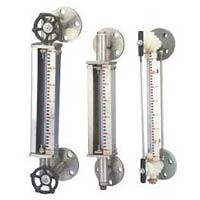
Level Indicator
Get Price Quote
Based in Hyderabad, Telangana we are one of the most-reliable manufacturer and supplier of Level Indicator. We offer Level Indicators in wide range of specifications and models to satisfy the client requirement. Manufactured using raw materials sourced from best-in-industry vendors, our Level Indicators come with an internationally acclaimed quality. These Level Indicators have applications in Oil filled Power Transformers and Oil filled Tanks.

Pressure Gauges
Get Price Quote
When selecting a pressure gauge, it is important to consider the following factors to ensure safety and accuracy: 1. Pressure fluid composition 2. Pressure fluid temperature 3. Ambient conditions 4. Pressure range 5. Conditions affecting wear of the system 6. Method of mounting 7. Required accuracy 1. Pressure fluid composition Since the sensing element of a pressure gauge may be exposed directly to the measured medium, consider the characteristics of this medium. It may be corrosive, it may solidify at various temperatures or it may contain solids that will leave deposits inside the sensing element. For pressure fluids that will not solidify under normal conditions or leave deposits, a Bourdon tube gauge is acceptable. Otherwise a Sealgauge or diaphragm seal should be used. A chemical compatibility chart follows this section to aid in the selection of the proper sensing element material. 2. Pressure fluid temperature Steam and other hot media may raise the temperature of the gauge components above safe working limits of the sealed joints. In these cases it is recommended that a siphon, cooling tower or diaphragm seal be used in conjunction with the pressure gauge. 3. Ambient conditions The normal ambient temperature range for WIKA pressure gauges is -40o F to +140o F (-40o C to +60o C) for dry or silicone-filled gauges and -4o F to +140o F (-20o C to +60o C) for glycerine-filled gauges. The error caused by temperature changes is +0.3% or -0.3% per 18o F rise or fall, respectively. The reference temperature is 70o F (20o C). The correction is for the temperature of the gauge, not the temperature of the measured medium. Remote gauge mounting using a diaphragm seal and capillary line is one alternative for applications involving extreme ambient temperature. Moisture and weather effects must also be considered. Liquid-filled gauges prevent condensation build up. For outdoor use, stainless steel, brass or plastic cased gauges are recommended. 4. Pressure range A gauge range of twice the working pressure is generally selected. The working pressure in all cases should be limited to 75% of the gauge range. Where alternating pressure and pulsation are encountered, working pressure should be limited to 2/3 of the gauge range. 5. Conditions affecting wear of the system In applications involving severe pressure fluctuation or pulsation, the use of restrictors and/or snubbers is recommended. In addition, liquid-filled gauges increase the service life of gauges in these conditions. WIKA liquidfilled gauges are generally filled with glycerine. Silicone for larger temperature extremes and Halocarbon® for use with oxidizing agents such as chlorine, oxygen and hydrogen peroxide are also available. 6. Method of mounting Radial (LM) and back (CBM or LBM) connections are available for most WIKA gauges. WIKA stocks gauges with standard NPT threaded connections. Other types such as metric threads, straight threads, hose barbs and special fittings are available as a special order. Pressure gauges should be mounted in the upright position. For applications where the gauge is mounted side ways, horizontally or upside down, contact WIKA Customer Service for gauge type compatibility. 7. Required accuracy WIKA stocks gauges with accuracies from ± 3/2/3% to ±0.1% of span (ASME Grade B to Grade 4A). To ensure safe and accurate gauge selection, you must take all of the above factors into consideration.
Best Deals from Measurement Gauge

electronic gauges
Get Price Quote
Restricting to the pre-defined quality parameters, we make sure that the offered array of products is as per the stated norms. In order to ensure zero damage during transit, we have adopted modern facility for meticulously packaging our offerings. And, we also ensure that the used material is of high quality.

Electronic Vacuum Gauge
15,000 Per Piece

Digital Differential Pressure Gauge
Get Price Quote
Digital Differential Pressure Gauges are digital readout monitors designed for measuring the room pressure inside Pharma clean rooms, hospital operation theaters & isolation rooms. This advanced gauge comes with 0.5% accuracy, capable of continuous measurement. Features Include: Unit Conversion at the Press of a Key Between mm.W.C. and Pascal’s, Integrated Buzzer Alarm for Set Point Violation, Offset Provision to Meet Audit Requirements, Analog 4-20ma Output, 30 mm. Profundity for Clean Room Modular Wall Fitment and RS 485 Modbus Communication For BMS/SCADA/PLC Integration.

Tipping Bucket Rain Gauge
Get Price Quote
The Tipping Bucket performs a wide range of rainfall measurements. The receiver is 200 mm in diameter. The Tipping Bucket measures each 0.2, 0.5, 1mm or 0.01 inch of rainfall. It could also include a siphon (optional) that allows rain to flow at a steady rate to the tipping bucket mechanism regardless of rainfall intensity. This system allows control of the “flow rate” of accumulated precipitation. This metering geometry assures higher levels in both accuracy and repeatability during periods of extremely heavy rainfall. Tipping bucket gauges operate by capturing a small volume of water in one of two small buckets as shown in Figure below. Once the rain is captured, the bucket tips and empties. The occurrence of this “tip” is recorded, and precipitation volumes and rates are transmitted as the number of tips and the rate at which they occurred. Tipping bucket rain gauges tend to underestimate precipitation during periods of intense rainfall and in case of frozen precipitation. All gauges tend to underestimate in high wind. But compared to weighing gauges, tipping bucket gauges are less expensive and demand significantly less maintenance. Our Tipping Bucket Rain Gauge is the only one Stainless Steel Tipping Bucket Rain Gauge for Cylinder, Base, Tipping Bucket, all metal.

Pressure Gauges
Get Price Quote
Selecting a pressure gauge when selecting a pressure gauge, it is important to consider the following factors to ensure safety and accuracy: 1. Pressure fluid composition 2. Pressure fluid temperature 3. Ambient conditions 4. Pressure range 5. Conditions affecting wear of the system 6. Method of mounting 7. Required accuracy

Force Gauges
Get Price Quote
Force Gauges, Barometer, Clamp Meter, Dew Point Meter, Digital Hygrometer

Glass Knobs
Get Price Quote
Glass Knobs, fixing bolts, Gates, Shower Fitting, Signage, Spider Fitting

Analog Gauge
Get Price Quote
Analog Gauge, Air hydraulic pump, Economy Toe Jack, Hydraulic Spreader

Glass Knobs
Get Price Quote
Glass Knobs, plywood products, hardware fittings, drawer knobs

Gauge Block Set
Get Price Quote
Gauge Block Set, Straight Edge, Gear Tooth Vernier Calipers, Magnetic Stand

Level Indicators
Get Price Quote
Level Indicators, Rotameters

Pressure Gauges
Get Price Quote
Humidity Meters, Instruments, scada systems, thermo wells, Calibrators

Telescopic Gauge
Get Price Quote
Telescopic Gauge, Precision Leveling Wedge, hydraulic vise